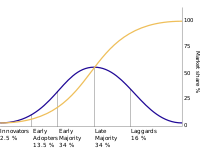
Photo from wikipedia
&NA; Diffusion MRI (dMRI) is a valuable tool in the assessment of tissue microstructure. By fitting a model to the dMRI signal it is possible to derive various quantitative features.… Click to show full abstract
&NA; Diffusion MRI (dMRI) is a valuable tool in the assessment of tissue microstructure. By fitting a model to the dMRI signal it is possible to derive various quantitative features. Several of the most popular dMRI signal models are expansions in an appropriately chosen basis, where the coefficients are determined using some variation of least‐squares. However, such approaches lack any notion of uncertainty, which could be valuable in e.g. group analyses. In this work, we use a probabilistic interpretation of linear least‐squares methods to recast popular dMRI models as Bayesian ones. This makes it possible to quantify the uncertainty of any derived quantity. In particular, for quantities that are affine functions of the coefficients, the posterior distribution can be expressed in closed‐form. We simulated measurements from single‐ and double‐tensor models where the correct values of several quantities are known, to validate that the theoretically derived quantiles agree with those observed empirically. We included results from residual bootstrap for comparison and found good agreement. The validation employed several different models: Diffusion Tensor Imaging (DTI), Mean Apparent Propagator MRI (MAP‐MRI) and Constrained Spherical Deconvolution (CSD). We also used in vivo data to visualize maps of quantitative features and corresponding uncertainties, and to show how our approach can be used in a group analysis to downweight subjects with high uncertainty. In summary, we convert successful linear models for dMRI signal estimation to probabilistic models, capable of accurate uncertainty quantification. HighlightsMany popular models for diffusion MRI can be reinterpreted as probabilistic ones.The uncertainty of any derived property can be quantified.The uncertainty quantification is comparable to residual bootstrap, but faster.It can be used in a group analysis to downweight subjects with high uncertainty.
Journal Title: NeuroImage
Year Published: 2018
Link to full text (if available)
Share on Social Media: Sign Up to like & get
recommendations!